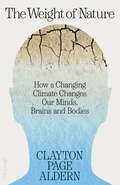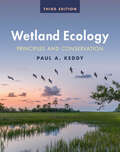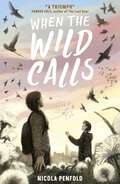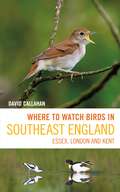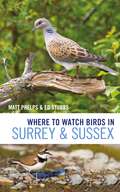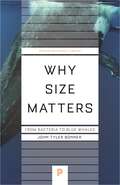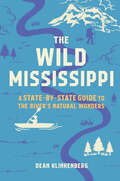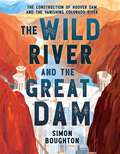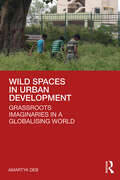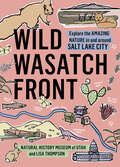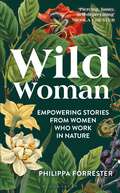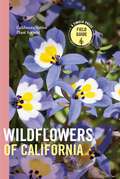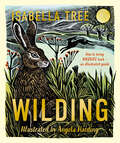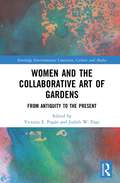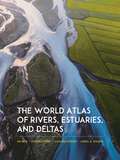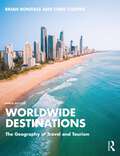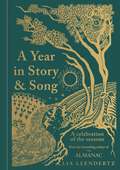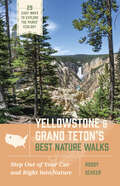- Table View
- List View
The Weight of Nature: How a Changing Climate Changes Our Minds, Brains and Bodies
by Clayton Aldern'Penetrating, intensely personal, and impossible to put down, this is a book you need to read.' Annie Proulx, winner of the Pulitzer Prize'This book is a triumph.' Bill McKibbenA riveting, revelatory account of how the climate emergency is changing us from the inside outIt is now inarguable that climate change threatens the future of life on Earth. But in The Weight of Nature, award-winning journalist and neuroscientist Clayton Page Aldern shows that the warming climate is not just affecting our planet – it is affecting our brains and bodies too. Drawing on seven years of ground-breaking research, Aldern documents a burgeoning public health crisis that has gone largely unreported. Eco-anxiety, he shows us, is just the tip of the iceberg. The rapidly changing environment is directly intervening in our brain health, behaviour, decision-making and cognition in real time, affecting everything from spikes in aggravated assault to lower levels of productivity and concentration, to the global dementia epidemic. Travelling the world to meet the scientists and doctors unravelling the tangled connections between us and our environment, and reporting the stories of those who are already feeling these shifts most keenly, Aldern shows how climate change isn’t just around us, but within us. Lucid, urgent and at times deeply moving, The Weight of Nature is a revelation, bringing to light the myriad ways in which the natural world tugs and prods at the decisions you make; how it twists and folds your memories and mental states; how this nebulous everywhere we call the environment is changing our very humanity from the inside out.
When the Wild Calls (Where the World Turns Wild #2)
by Nicola PenfoldHaving escaped their city, Juniper Greene and her brother Bear have settled in Ennerdale with their dad and his family. Every day the wild introduces them to a new wonder, but Juniper can't stop worrying about her grandmother and best friend left behind. When she hears news that disease has entered the city, she's determined to bring her loved ones to safety. Trapped in a city riddled with disease and run by a ruthless leader, Etienne longs for the wild. With the guards becoming more aggressive to counteract the growing rebellion, Etienne's prepared to fight for his freedom. But will he be able to protect himself and keep those around him safe until Juniper returns from the wild?
Where to Watch Birds in Southeast England: Essex, London and Kent (Where to Watch Birds)
by David CallahanThe definitive site guide to a surprisingly bird-rich corner of England – Kent, Essex and the Greater London area.From the deep forests of Kent to the low-lying mudflats, beaches and saltmarshes of the Greater Thames Estuary, this ecologically rich area of England attracts vast numbers of wildfowl and waders. The region boasts many internationally and nationally important reserves including Rainham Marshes and Cliffe Pools, while Dungeness in Kent is one of Britain's best known birding hotspots for vagrant species such as Penduline Tit and Kentish Plover. London itself contains numerous birdwatching sites including Barnes and Woodberry Wetlands, along with some of the best spots in Britain for scarcities such as Lesser Spotted Woodpecker and Black Redstart. From Marsh Harrier and Firecrest to Curlew and Lapwing, there is plenty for birdwatchers to enjoy while exploring the parks, wetlands, woodlands and coast of southeast England. Written by life-long birdwatcher David Callahan, this is the definitive guide to the birding highlights of the region. It contains a comprehensive review of all the major sites and many lesser-known ones, with maps, notes on access, and information on target species and when to visit. Where to Watch Birds in Southeast England is indispensable for any birder exploring the region, or anyone in London wanting to head out to the countryside and enjoy a slice of our rich avian heritage.
Where to Watch Birds in Surrey and Sussex (Where to Watch Birds)
by Matthew Phelps Ed StubbsThis site guide covers the counties of East Sussex, West Sussex and Surrey, including sites in southwest Greater London. From the heaths of Surrey to the chalky grassland of the North and South Downs, the great forests of the Weald and the headlands, shingle beaches and river valleys of England's south coast, these three counties are a bird-rich part of the country, with perhaps the most diverse range of habitats in the country, and all within easy distance of London, the southwest part of which contains birding sites such as Barnes wetland centre.This new book by Matthew Phelps and Ed Stubbs is the definitive guide to the birding highlights of the region. It contains a comprehensive review of all the major sites, and many lesser-known ones, with maps, notes on access, and information on target species and when to visit. Where to Watch Birds in Surrey and Sussex is indispensable for any birder heading to this bird-rich region, or anyone in London who wants to head south to enjoy some of the best birding England can offer.
Why Size Matters: From Bacteria to Blue Whales (Princeton Science Library #142)
by John Tyler BonnerJohn Tyler Bonner, one of our most distinguished and creative biologists, here offers a completely new perspective on the role of size in biology. In his hallmark friendly style, he explores the universal impact of being the right size. By examining stories ranging from Alice in Wonderland to Gulliver's Travels, he shows that humans have always been fascinated by things big and small. Why then does size always reside on the fringes of science and never on the center stage? Why do biologists and others ponder size only when studying something else—running speed, life span, or metabolism?Why Size Matters, a pioneering book of big ideas in a compact size, gives size its due by presenting a profound yet lucid overview of what we know about its role in the living world. Bonner argues that size really does matter—that it is the supreme and universal determinant of what any organism can be and do. For example, because tiny creatures are subject primarily to forces of cohesion and larger beasts to gravity, a fly can easily walk up a wall, something we humans cannot even begin to imagine doing.Bonner introduces us to size through the giants and dwarfs of human, animal, and plant history and then explores questions including the physics of size as it affects biology, the evolution of size over geological time, and the role of size in the function and longevity of living things.As this elegantly written book shows, size affects life in its every aspect. It is a universal frame from which nothing escapes.
Why Size Matters: From Bacteria to Blue Whales (Princeton Science Library #142)
by John Tyler BonnerJohn Tyler Bonner, one of our most distinguished and creative biologists, here offers a completely new perspective on the role of size in biology. In his hallmark friendly style, he explores the universal impact of being the right size. By examining stories ranging from Alice in Wonderland to Gulliver's Travels, he shows that humans have always been fascinated by things big and small. Why then does size always reside on the fringes of science and never on the center stage? Why do biologists and others ponder size only when studying something else—running speed, life span, or metabolism?Why Size Matters, a pioneering book of big ideas in a compact size, gives size its due by presenting a profound yet lucid overview of what we know about its role in the living world. Bonner argues that size really does matter—that it is the supreme and universal determinant of what any organism can be and do. For example, because tiny creatures are subject primarily to forces of cohesion and larger beasts to gravity, a fly can easily walk up a wall, something we humans cannot even begin to imagine doing.Bonner introduces us to size through the giants and dwarfs of human, animal, and plant history and then explores questions including the physics of size as it affects biology, the evolution of size over geological time, and the role of size in the function and longevity of living things.As this elegantly written book shows, size affects life in its every aspect. It is a universal frame from which nothing escapes.
The Wild Mississippi: A State-by-State Guide to the River's Natural Wonders
by Dean KlinkenbergDiscover the amazing flora and fauna of the Mississippi River—and the best ways to explore it, state by state! Did you know that one-quarter of all North American fish species are native to the Mississippi? Or that it shelters 300 species of birds during seasonal migrations? The Mississippi River runs through the heart of the nation, shaping its history and identity. But few of us understand its essences. It&’s a life-giving force that sustains thriving ecosystems across wetlands, prairies, and bluffs. In The Wild Mississippi, Dean Klinkenberg not only shares the wonders of the river, but he also shows you where to experience them firsthand. Pick up this must-read guide and get ready to experience the river wild! You&’ll discover: Hiking, biking, and paddling spots More than 160 parks, forests, and wildlife refuges Natural history museums and aquariums Excursions from Minneapolis, St. Louis, Memphis, New Orleans, and more
The Wild River and the Great Dam: The Construction of Hoover Dam and the Vanishing Colorado River
by Simon Boughton★ "In this detailed and informative work, Boughton chronicles the construction of the Hoover Dam via compellingly comprehensive text." —Publishers Weekly, starred review ★ "This well-written narrative is bound to become the authority on this modern American marvel." —Booklist, starred review"A fascinating blend of social and environmental history and engineering." —Kirkus Reviews "Truly breathtaking. This is a powerful story and like the water slowly rising behind that concrete barrier, it becomes more powerful with each page turn." —David Macaulay, two-time recipient of the Caldecott Medal and creator of the bestselling The Way Things Work"An exciting mix of research, storytelling, and an astounding true story—one that&’s still unfolding today." —Steve Sheinkin, three-time National Book Award finalist and Newbery Honor author of Bomb Discover the complicated history behind the construction of Hoover Dam—one of the country&’s most recognizable and far-reaching landmarks—and its lasting political and environmental effects on the Colorado River and the American West. At the time of its completion in 1936, Hoover Dam was the biggest dam in the world and the largest feat of architecture and engineering in the country—a statement of national ambition and technical achievement. It turned the wild Colorado River into a tame and securely managed water source, transforming millions of acres of desert into farmland while also providing water and power to the fast-growing population of the Southwest. The concrete monolith quickly became a symbol of American ingenuity; however, its history is laden with contradiction. It provided work for thousands, but it was a dangerous project that exploited desperate workers during the Depression. It helped secure the settlement and economies of the Southwest, but at the expense of Indigenous peoples and the environment; and it created a dependency on the Colorado River&’s water, which is under threat from overuse and climate change. Weaving together elements of engineering, geography, and political and socioeconomic history, and drawing heavily from unpublished oral histories taken from dam workers and their families, Simon Boughton&’s thoughtful and compelling debut—featuring historical photographs throughout—follows the construction and impact of Hoover Dam, and how its promise of abundance ultimately created a river in crisis today.
Wild Spaces in Urban Development: Grassroots Imaginaries in a Globalising World
by Amartya DebThis fascinating book examines how microsites of spontaneous nature can reframe our understanding of the relationship between urban development and green space. Metropolitan cities are facing stark inequalities of green space distribution, hindering goals of sustainable development. But outside of human control, spontaneous nature grows in spaces that are neglected or are unaccounted for. Drawing on existing literature and primary research in a range of towns and cities, including Quito in Ecuador, Bengaluru and Kolkata in India, and Whitby in the United Kingdom, the book delves into the morphology, meanings, and values of those small-scale assemblages of wild growth which are typically overlooked. Discussing instead how such settings can be integrated into everyday urban life, the book offers a fresh perspective on issues around green infrastructure, heritage conservation, and environmental education, enabling cities worldwide to become more nature-positive. A unique examination of an under-researched topic, this book will appeal to students, researchers, and professionals across landscape architecture, urban planning, urban ecology, and all related fields.
Wild Spaces in Urban Development: Grassroots Imaginaries in a Globalising World
by Amartya DebThis fascinating book examines how microsites of spontaneous nature can reframe our understanding of the relationship between urban development and green space. Metropolitan cities are facing stark inequalities of green space distribution, hindering goals of sustainable development. But outside of human control, spontaneous nature grows in spaces that are neglected or are unaccounted for. Drawing on existing literature and primary research in a range of towns and cities, including Quito in Ecuador, Bengaluru and Kolkata in India, and Whitby in the United Kingdom, the book delves into the morphology, meanings, and values of those small-scale assemblages of wild growth which are typically overlooked. Discussing instead how such settings can be integrated into everyday urban life, the book offers a fresh perspective on issues around green infrastructure, heritage conservation, and environmental education, enabling cities worldwide to become more nature-positive. A unique examination of an under-researched topic, this book will appeal to students, researchers, and professionals across landscape architecture, urban planning, urban ecology, and all related fields.
Wild Wasatch Front: Explore the Amazing Nature in and around Salt Lake City (Wild Series)
by Natural History Museum of UtahA vibrant, informative guide to the unexpected nature in Salt Lake City and the surrounding area. Set out on a field trip with the experts from the Natural History Museum of Utah. In this book, you&’ll learn about over 100 local species, both plants and animals. Be on the lookout for painted turtles in Ogden, spot pelicans soaring over Provo, and identify pavement mushrooms in Salt Lake City. Equal parts field guide and trip planner, Wild Wasatch Front reveals the unexpected nature thriving in parks, beside urban streams, along local trails… and maybe even in your own backyard.
Wild Woman: Empowering Stories from Women who Work in Nature
by Philippa ForresterAn engaging blend of conservation stories and humorous, personal anecdotes from Philippa Forrester about women who, like her, choose to live and work in the wild.Surviving in the wilderness has long been associated with men, and conservation and environmental biology have traditionally been male-dominated subjects. Yet many remarkable women also choose to live and work in wild and challenging landscapes. In Wild Woman, Philippa Forrester considers the grit and determination required for women to maintain connections to wildlife and shares stories of female conservation heroes and other extraordinary wild women working in nature. Talking to women from around the world, Philippa studies and celebrates what it means to be a wild woman. From the sixteenth-century botanist who was the first woman to circumnavigate the globe to modern-day women responding to bear attacks in Yellowstone, working to rewild reserves in South Africa, photographing Caribou in the Arctic and more, Philippa examines how these women benefit from a life spent in the wilderness and also considers what the natural world gains from them. Relating some of her own experiences from three decades spent travelling around the world and working in some of the wildest places on Earth, Philippa asks: what does it take for a woman to live or work in the wild?
Wildflowers of California
by California Native Plant SocietyExperience the vibrant diversity of West Coast Wildflowers with this amazing, informative guide to more than 1,200 plant species.Wildflowers of California is a comprehensive field guide for anyone wishing to learn about the amazingly diverse wildflowers of the region. Organized by flower color and shape, and including a range map for each flower described, the guide is as user-friendly as it is informative. This must-have book is perfect for hikers, naturalists, and native plant enthusiasts. Describes and illustrates 1200 commonly encountered species Includes perennials, annuals, and shrubs, both native and nonnative Thousands of superb color photographs and range maps User-friendly organization by flower color and shape
Wilding: How To Bring Wildlife Back - An Illustrated Guide
by Isabella TreeWilding: How to Bring Wildlife Back - An Illustrated Guide is a stunningly beautiful gift book written by Isabella Tree which tells the story of the Knepp Estate in West Sussex. It is illustrated in full colour with lino prints and watercolours by Angela Harding (A Year Unfolding) and photographs from Knepp.Knepp is now home to some of the rarest and most beautiful creatures in the UK, including nightingales, kingfishers, turtle doves and peregrine falcons, hazel dormice and harvest mice, scarce chaser dragonflies and purple emperor butterflies. The sheer abundance of life is staggering too. When you walk out into the scrubland on an early spring morning the sound of birdsong is so loud it feels like it’s vibrating in your lungs. This is the story of Knepp, and a guide telling you how to bring wildlife back where you live.Includes timelines, an indepth look at rewilding, spotlight features about native animals including species that have returned and thrive - butterflies, bats, owls and beetles. There are accessible in-garden activities to 're-wild' your own spaces and the book encourages you to slow down and observe the natural world around you, understand the connections between species and habitats, and the huge potential for life right on your doorstep.
Women and the Collaborative Art of Gardens: From Antiquity to the Present (Routledge Environmental Literature, Culture and Media)
Women and the Collaborative Art of Gardens explores the garden and its agency in the history of the built and natural environments, as evidenced in landscape architecture, literature, art, archaeology, history, photography, and film. Throughout the book, each chapter centers the act of collaboration, from garden clubs of the early twentieth century as powerful models of women’s leadership, to the more intimate partnerships between family members, to the delicate relationship between artist and subject. Women emerge in every chapter, whether as gardeners, designers, owners, writers, illustrators, photographers, filmmakers, or subjects, but the contributors to this dynamic collection unseat common assumptions about the role of women in gardens to make manifest the significant ways in which women write themselves into the accounts of garden design, practice, and history. The book reveals the power of gardens to shape human existence, even as humans shape gardens and their representations in a variety of media, including brilliantly illuminated manuscripts, intricately carved architectural spaces, wall paintings, black and white photographs, and wood cuts. Ultimately, the volume reveals that gardens are best apprehended when understood as products of collaboration. The book will be of interest to scholars and students of gardens and culture, ancient Rome, art history, British literature, medieval France, film studies, women’s studies, photography, African American Studies, and landscape architecture.
Women and the Collaborative Art of Gardens: From Antiquity to the Present (Routledge Environmental Literature, Culture and Media)
by Victoria E. Pagán Judith W. PageWomen and the Collaborative Art of Gardens explores the garden and its agency in the history of the built and natural environments, as evidenced in landscape architecture, literature, art, archaeology, history, photography, and film. Throughout the book, each chapter centers the act of collaboration, from garden clubs of the early twentieth century as powerful models of women’s leadership, to the more intimate partnerships between family members, to the delicate relationship between artist and subject. Women emerge in every chapter, whether as gardeners, designers, owners, writers, illustrators, photographers, filmmakers, or subjects, but the contributors to this dynamic collection unseat common assumptions about the role of women in gardens to make manifest the significant ways in which women write themselves into the accounts of garden design, practice, and history. The book reveals the power of gardens to shape human existence, even as humans shape gardens and their representations in a variety of media, including brilliantly illuminated manuscripts, intricately carved architectural spaces, wall paintings, black and white photographs, and wood cuts. Ultimately, the volume reveals that gardens are best apprehended when understood as products of collaboration. The book will be of interest to scholars and students of gardens and culture, ancient Rome, art history, British literature, medieval France, film studies, women’s studies, photography, African American Studies, and landscape architecture.
Workers of the Earth: Labour, Ecology and Reproduction in the Age of Climate Change
by Stefania BarcaCapitalism is destroying our planet, but like most social progress in the last two centuries, ecological justice can only be achieved through working-class struggle.In Workers of the Earth, Stefania Barca uncovers the environmental history and political ecology of labour to shed new light on the potentiality of workers as ecological subjects. Taking an ecofeminist approach, this ground-breaking book makes a unique contribution to the emerging field of environmental labour studies, expanding the category of labour to include waged and unwaged, industrial and meta-industrial workers.Going beyond conventional categories of ‘production’ and ‘reproduction’ as separate spheres of human experience, Barca offers a fresh perspective on the place of labour in today’s global climate struggle, reminding us that the fight against climate change is a fight against capitalism.
The World Atlas of Rivers, Estuaries, and Deltas
by Jim Best Stephen Darby Luciana Esteves Carol WilsonA stunningly illustrated atlas of the world&’s rivers, estuaries, and deltas, and their ecosystemsFrom the Congo and the Mekong to the Seine and the Mississippi, Earth&’s rivers carve through landscapes before coursing into the world&’s oceans through estuaries and deltas. Their inexorable flow carries sediment and more, acting as lifeblood for a variety of ecosystems and communities. More than any other surface feature of Earth, rivers, estuaries, and deltas are vitally important to our economic and social well-being, and our management of them often sits at the sharp edge of today&’s most pressing environmental challenges. The World Atlas of Rivers, Estuaries, and Deltas takes readers on an unforgettable tour of these dynamic bodies of water, explaining how they function at each stage of their flow. Combining maps and graphics with informative essays and beautiful photos, this invaluable reference book will give you a new appreciation for the power that rivers, estuaries, and deltas wield.Features a wealth of color photos, maps, and infographicsBrings together invaluable perspectives from leading expertsDescribes the rich biodiversity associated with the world&’s rivers, estuaries, and deltasExplains how rivers, estuaries, and deltas work, from river networks to deltaic floodplains, and sheds light on the erosion, movement, and deposition of sedimentDescribes the anatomy of rivers, estuaries, and deltas, from channel geometry and river planforms to estuarine shape and delta morphologyExamines the ecology and ecosystems of rivers, estuaries, and deltas and how humans interact with these environmentsAdditional topics include damming, climate change, water use, pollution, resource management, and planetary health, as well as future perspectives on these vital landscapes
World Review: Environmental and Sustainability Education in the Context of the Sustainable Development Goals
The global landscape of education has been reshaped by the COVID-19 pandemic, revealing the various challenges faced by countries worldwide. This book provides a comprehensive exploration of Environmental and Sustainability Education (ESE) across different countries, offering unique insights into their histories, challenges, achievements, and future ESE needs. From Africa to Oceania, the book delves into the vital role of ESE in the context of the UN Sustainable Development Goals. It highlights the diverse national discourses and the flexibility required to deliver effective global education programs. ESE practitioners, researchers, and policymakers worldwide will find inspiration and invaluable perspectives in this book.
World Review: Environmental and Sustainability Education in the Context of the Sustainable Development Goals
by Marco Rieckmann Rosalba Thomas MuñozThe global landscape of education has been reshaped by the COVID-19 pandemic, revealing the various challenges faced by countries worldwide. This book provides a comprehensive exploration of Environmental and Sustainability Education (ESE) across different countries, offering unique insights into their histories, challenges, achievements, and future ESE needs. From Africa to Oceania, the book delves into the vital role of ESE in the context of the UN Sustainable Development Goals. It highlights the diverse national discourses and the flexibility required to deliver effective global education programs. ESE practitioners, researchers, and policymakers worldwide will find inspiration and invaluable perspectives in this book.
Worldwide Destinations: The Geography of Travel and Tourism
by Brian Boniface Chris CooperWorldwide Destinations: The Geography of Travel and Tourism is a unique text that explores tourism demand, supply, organisation, and resources for every country worldwide in a logically structured and accessible format.The ninth edition is fully updated to include the following features: Greater exploration of current issues such as climate change, the impact of COVID-19 on destinations and subsequent recovery strategies, regenerative tourism, changes in consumer behaviour, and sustainability New and updated case studies throughout Increased emphasis on South America and a new chapter focussing on the tourism geography of Antarctica Enhanced online resources for lecturers and students including PPTs, web links, video links, MCQs, and discussion questions The first part of this book comprises thematic chapters that detail the geographic knowledge and principles required to analyse the tourism appeal of destinations. The subsequent division of this book into regional chapters enables the student to carry out a systematic analysis of a particular destination by providing insights on cultural characteristics as well as information on specific places.This volume is an invaluable resource for studying every destination in the world, explaining tourism demand, evaluating the many types of tourist attractions, and examining the trends that may shape the future geography of tourism. This thorough guide is a must-have for any student undertaking a course in travel and tourism.
Worldwide Destinations: The Geography of Travel and Tourism
by Brian Boniface Chris CooperWorldwide Destinations: The Geography of Travel and Tourism is a unique text that explores tourism demand, supply, organisation, and resources for every country worldwide in a logically structured and accessible format.The ninth edition is fully updated to include the following features: Greater exploration of current issues such as climate change, the impact of COVID-19 on destinations and subsequent recovery strategies, regenerative tourism, changes in consumer behaviour, and sustainability New and updated case studies throughout Increased emphasis on South America and a new chapter focussing on the tourism geography of Antarctica Enhanced online resources for lecturers and students including PPTs, web links, video links, MCQs, and discussion questions The first part of this book comprises thematic chapters that detail the geographic knowledge and principles required to analyse the tourism appeal of destinations. The subsequent division of this book into regional chapters enables the student to carry out a systematic analysis of a particular destination by providing insights on cultural characteristics as well as information on specific places.This volume is an invaluable resource for studying every destination in the world, explaining tourism demand, evaluating the many types of tourist attractions, and examining the trends that may shape the future geography of tourism. This thorough guide is a must-have for any student undertaking a course in travel and tourism.
A Year in Story and Song: A Celebration of the Seasons
by Lia LeendertzA Year in Story and Song is a captivating collection of stories and songs that celebrates the seasons. We humans love stories. We love to hear them and to tell them, around fires and by bedsides, and we love to use them to make sense of the world around us. The seasons, in all their ever-changing variety, give us many opportunities for storytelling: the full moons and their names, Epiphany in January, St Patrick's Day in March, May Day, Midsummer, Halloween and more. They feature mischievous boggarts and fairies, saints and sailors, leprechauns and dragons, pilgrimages and charms, milk maids and rose queens, Robin Hood and the green man. The songs range from shanties and love songs, to bawdy ballads and wassails, to carols and rounds, and have been sung for hundreds of years, often at particular moments in the calendar.This is a book to treasure all year, every year.
Yellowstone and Grand Teton’s Best Nature Walks: 29 Easy Ways to Explore the Parks' Ecology
by Roddy ScheerPlan out your trip on some of America's most beautiful natural wonders with this indispensable guide to the flora, fauna, geology, and hiking trails of Yellowstone and the Grand Tetons. Step out of your car and right into nature! Yellowstone and Grand Teton&’s Best Nature Walks by Roddy Scheer guides you through simple hikes that feature the best of the park&’s rich ecology. Each entry starts with the brief description of the hike's level of difficulty—all are gentle to moderate and cover no more than two miles. Entries also include directions and clear descriptions of the flora, fauna, and geology you are likely to encounter along the way. Yellowstone and Grand Teton&’s Best Nature Walks is a must-have guide for outdoor enthusiasts, hikers, and tourists.
